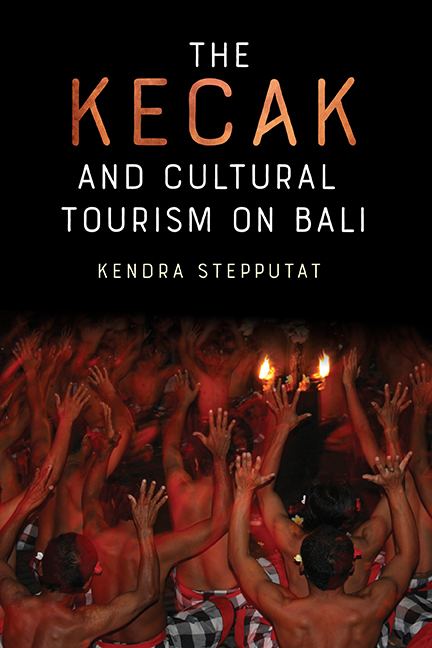Book contents
- Frontmatter
- Contents
- Acknowledgments
- Note to the Reader
- Introduction
- Part 1 The Present
- Part 2 The History
- Appendix 1 Kecak dan Wisata Budaya di Bali (Indonesian Summary)
- Appendix 2 Kecak Groups of Bali in 2000–2001 (Badung and Gianyar)
- Appendix 3 Facsimile of a Letter from Walter Spies to Leo Spies, 1932
- Glossary
- Bibliography
- Index
5 - Kecak: The Tourist Performance
Published online by Cambridge University Press: 07 October 2022
- Frontmatter
- Contents
- Acknowledgments
- Note to the Reader
- Introduction
- Part 1 The Present
- Part 2 The History
- Appendix 1 Kecak dan Wisata Budaya di Bali (Indonesian Summary)
- Appendix 2 Kecak Groups of Bali in 2000–2001 (Badung and Gianyar)
- Appendix 3 Facsimile of a Letter from Walter Spies to Leo Spies, 1932
- Glossary
- Bibliography
- Index
Summary
In 1996, DeBoer wrote that “from the earliest commentaries we have, Western observers have tended to favor Balinese theater forms emphasizing spectacle over those emphasizing language […]. ‘Serious’—preferably sacred—forms have been likewise preferred.” Kecak fulfills both criteria; it is a spectacle with a “sacred” flavor. Kecak has been an instant success with visitors to Bali, and from the beginning performances were catered to travelers’ needs and interests. With few exceptions, there is no tradition of kecak being performed for a Balinese audience. The performance context, therefore, is closely tied to the phenomenon of tourism and more specifically cultural tourism on Bali.
The Study of Tourism and Culture
The study of tourism as a branch of anthropology has been part of anthropological discourse since the mid-1970s. Publications dealing with tourism as a global phenomenon initially focused on the aspect of “acculturation,” that is, the personal and cultural encounter between “host” and “guest,” as in the first substantial compendium on the subject by Valene Smith. Another aspect, the economy behind touristic encounters, was long ignored, as Schouten laments: “Tourism is still haunted by the myth of the host and the guest, a concept that largely ignores the economic exchange that is at the basis of the tourist's experience.” Recent publications show that economic factors are slowly emerging as a focus of attention.
Dunbar-Hall points out that music is very often part of the cultural tourism experience. In the 1980s, the first publications in ethnomusicology dealing with music and related arts in tourist contexts appeared and were followed irregularly by similar publications. Over the course of the 1990s, an underrepresented aspect of tourism research came to the attention of both anthropologists and ethnomusicologists. A new branch of tourism anthropology developed, the anthropology of cultural tourism. Cultural tourism is generally seen as a phenomenon wherein tourists travel to places in order to witness certain cultural phenomena (heritage sites, museums, visual arts) or events (rituals, performing arts). What is offered as “culture” and the interests or goals that tourists have, however, differ tremendously. Schouten states that “cultural tourism is difficult to define, and it is not a single market. It looks more like a continuum from incidental encounters with cultural phenomena to intentional decision making based on cultural preferences.”
- Type
- Chapter
- Information
- The Kecak and Cultural Tourism on Bali , pp. 148 - 192Publisher: Boydell & BrewerPrint publication year: 2021

